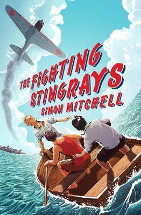The Fighting Stingrays by Simon Mitchell

Penguin Random House Australia, 2017. ISBN 9780143784104
(Age: Year 9+) Charlie, Masa and Alf are best mates living on
idyllic Thursday Island. While they spend their childhood playing
soldiers at war, they are also surrounded by the Aussie troops
defending the Torres Strait. The lads are all counting the days
until they can sign up for the Airforce like Biggles, their cult
hero. One morning, news breaks that Japan has mounted a full scale
attack on Australia's allies in both Pearl Harbor and The
Philippines. Suddenly all of the Japanese Islanders (even those who
have never lived off the island) are herded into a prison camp by
Captain Maddox, who is both domineering and taking full advantage of
his position. With the help of his mates, Masa escapes and spends a
large part of the second half of the story living in makeshift
shelter on the island and hiding from his enemies. However, Captain
'Maggots' isn't finished with him yet and starts hunting.
The main character's contrasting personalities are well established
during the early part of the book. Charlie lives in the big house,
his Father is the owner of Pearl Shell Company but the family unit
has a sad history and is struggling. Alf has a tough life; his Dad
is the local alcoholic who regularly beats him and his brother is in
Darwin fighting the war. Masa is a Japanese Australia, whose Dad is
the lead diver on one of Mr Napier's luggers. Captain Maddox, the
young army captain, shows his prejudices towards the 'Japs' and
becomes more and more fanatic as the story goes on.
The novel themes include how friendships are tested during war time
and also how even strong relationships are influenced by the media
of the day. With real historical events to draw on, including the
stories of his Islander grandmother, the author uses the perspective
of the teenagers to describe life amidst the Defense Force on alert
for an impending attack. The author uses colloquialisms of the day
as well, which would make for an interesting comparative task. The
story itself was highly enjoyable and would be a great unit for
Middle Years students.
Clare Thompson